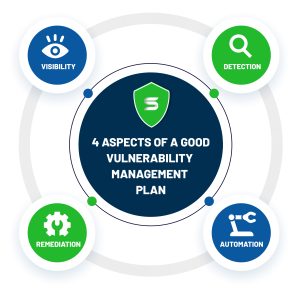Do you worry about the security of your organization? Do you think it is too difficult to create and implement the right vulnerability management plan that ticks all the right boxes by using the right vulnerability management tool?
The need for robust vulnerability management plans is essential due to the rising number of cyber-attacks. Prevention is better than cure and strong defense is better than a weak cure. Also, a patch management software can remediate vulnerabilities.
Whether it’s from a security perspective or for the upcoming audits for compliance, a solid vulnerability management plan makes the job easier, the organization safer and the machines efficient.
What is a Vulnerability Management Plan?
A vulnerability management plan is a detailed set of rules and tools which can be used to identify, assess and remediate vulnerabilities resulting in safer networks and endpoints in the organization. Vulnerability management contains 4 steps which are discovery, prioritize, remediate and report.
Having a basic Vulnerability management plan that can detect threats and remediate them can protect an organization from security breaches and cyber-attacks. It becomes the foundation for your vulnerability management process. It can also help in making sure that the systems in the organization are following the necessary rules and regulations in its domain.
Whether it’s HIPAA, PCI, NIST, or any other regulatory compliance, making sure that your organization is compliant with standard regulations can save you from a lot of trouble and unnecessary expenses. Following these regulations only bolsters the reputation and the security of your organization. A standard vulnerability management plan ensures your devices are clean and are working in their most efficient state. Nobody likes a computer that’s slow and not responding.
How do Vulnerability Management Plans Work?
Vulnerability management plans work like a checklist. These plans contain a list of essential checks associated with vulnerabilities and can also contain some standard regulations provided by various regulatory bodies or custom organization policies.
This is usually done automatically by software or can also be done manually. These checklists can vary based on what you would like to achieve i.e., security, compliance, productivity-related or a mix of all.
Types of Vulnerability Management Plans:
Vulnerability management plans can be broadly classified into 3 types based on the typical needs of an organization.
Security Focused Vulnerability Management Plans: Arguably the most popular and the most useful vulnerability management plan, it is a comprehensive checklist that encompasses typical issues in security along with standard safety regulations faced by an organization. It also makes sure the endpoints are efficient and provides the best possible vulnerability management for the organization.
Compliance Focused Vulnerability Management Plans: Primarily used to assure the organization is compliant with typical regulations of its business domain. This plan varies with industries. Usually, regulations are more stringent in the healthcare and BFSI sectors, so that businesses can safely store sensitive data. Hence, the checklists differ.
Productivity Focused Vulnerability Management Plans: As the name suggests, productivity focused plans prioritizes device performance over other aspects. Nobody likes a laggy computer, and IT admins hate the vulnerable ones. By having productivity-based plans, your team can give their 100% and not be hindered by faulty devices.
How do You Choose the Best Vulnerability Management Plan?
There is no such thing as a “Best Vulnerability Management plan“. Every day thousands of new vulnerabilities are reported by security researchers, analysts and software vendors. Continuously detecting and remediating them in your environment is a humongous task. Moreover, being unable to automate some of the manual tasks adds to a security admin’s pain. We must choose a plan that can satisfy our needs and more. Whether it is security, compliance, or productivity, a vulnerability management plan that is so comprehensive that its vulnerability scans take too much time is not efficient and useful at all.
The right balance of proper rules and tools, with a systematic routine, helps in the safety of your organization. All organizations have different policies and having a vulnerability management plan that keeps up the standard and also provides an additional layer of safety is not a bad idea at all.
Download SecPod’s Vulnerability Management Checklist to strengthen your organization’s defense.
The Need for Vulnerability Management Plans and Their Benefits:
With the growing amount of cyber-attacks on all domains and industries, it’s high time every organization take strategic decisions and implement robust VM plans to protect themselves from these attacks. More important is to being able to build such a strong defense that prevents any cyber-attacks. The fundamental principle of a VM plan is to provide much-needed protection against threat actors. But it also has other benefits which can improve the overall efficiency of the organization.
Some of the other benefits include:
- Compliance: Compliance is an integral part of the successful running of an organization. Following the standard rules and regulations implies that the organization is well protected against vulnerabilities, which in turn builds trust and confidence among your customers for the safe-keeping of their data. This also implies that the organization is confident in the security systems in place.
- Efficiency: Faster machines are better machines and safer machines are faster machines. Malware and viruses slow down computers and have long-lasting negative effects. Having a vulnerability management plan that can also remediate and patch out these vulnerabilities keeps the machines in their best state.
- Productivity: Closely linked to efficiency, faster machines help your team get the job done quickly, which in turn increases the productivity of the company. Laggy computers are frustrating and do nothing but slow you down. A vulnerability management plan can iron out these problems and make work easier.
- Reporting & Auditing: The most tedious part of an organization is auditing, which is directly dependent on reporting. Generation of reports become difficult if it is done manually, and they also become lengthy and bulky during the auditing process. An automated vulnerability management plan can help in making this process easier automatically generating audit-ready reports for easy usage.
- Continuity & Automation: Automating monotonous tasks, while making the scanning and remediating process continuous, can be a game-changer, and it can go a long way in helping your organization become more secure and also helping your security admins’ life a little easier.
Read: Continuous and Automated Vulnerability Remediation
You can also read these threat research and intelligence blogs for more insights.
Conclusion:
The need for a vulnerability management solution that can tick all the boxes is critical in this digital age. The world is fast moving and efficiently managing an organization while manually keeping track of compliance, generating reports for audits and all the while securing your network and endpoints is a herculean task.
With SanerNow, our comprehensive endpoint security suite which handles complete security of your devices and network, it’s a one-stop solution for all your problems. Built-in with world’s fastest vulnerability scans using the world’s largest SCAP repo along with other integral tools like patch management for automated patching of vulnerabilities, SanerNow makes security and compliance management elementary.
We are SecPod, and we prevent cyberattacks.
Schedule a free demo now!!!!


